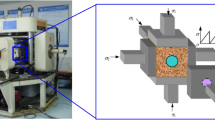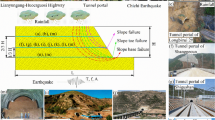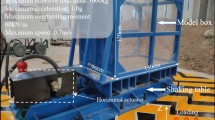Abstract
When a rock mass shears along a structural plane, the shear resistance of the structural plane is affected by the structural plane undulations and by the friction between the contact regions. During an earthquake, the seismic load (composed of the cyclic and dynamic loads) produces a dynamic deterioration of the mechanical properties of the structural plane, which is mainly reflected as follows: (1) under cyclic shear of the seismic load, the undulant angle αk decreases. (2) Under the dynamic load, the frictional coefficient of the structural surface is reduced. The dilatancy angle is generally used instead of the undulant angle. When calculating rock slope stability, the frictional angle is equivalent to the sum of the basic frictional angle and the undulant angle. In this study, the equations for calculating the dilatancy angle of a structural plane under cyclic shear loading are determined based on cyclic shear tests of a split structural plane. The basic frictional angle for calculating the cyclic shear is also determined, based on previous research. Furthermore, according to the dynamic model of a rock slope, a method to calculate the permanent displacement of the rock slope is proposed, considering the effect of structural plane deterioration. We found that the effect of structural plane deterioration under a seismic load directly affects the stability and permanent displacement of the rock slope. The feasibility and engineering practicalities of this method are also verified by comparing the proposed method with previously developed methods.

















Similar content being viewed by others
Abbreviations
- R h :
-
Maximum height of the surface roughness profile
- R p :
-
Maximum contour peak height
- R v :
-
Maximum contour valley depth
- S A :
-
Contour area ratio
- A t :
-
Developed contour surface area
- A n :
-
Sampling area
- A c :
-
Structural surface contact area
- JMC:
-
Joint Matching Coefficient
- α i :
-
Average shear dilatancy angle
- i :
-
Cyclic shear times
- σ c :
-
Intact rock strength
- α 0 :
-
Initial undulant angle
- φ i :
-
Basic frictional angle
- φ 0 :
-
Initial basic frictional angle
- φ r :
-
Residual basic frictional angle
- α r :
-
Residual undulant angle
- \(\varphi_{{\text{s}}}^{*}\) :
-
Residual equivalent friction angle
- C :
-
Cohesion
- M :
-
Mass of the landslide
- Β :
-
Dip angle of the sliding surface
- \(\ddot{u}_{{\text{g}}}\) :
-
Seismic acceleration
- θ:
-
Angle between the direction of the earthquake motion and the horizontal direction
- F s :
-
Safety factor
- φ b :
-
Basic frictional angle
- α k :
-
Undulant angle
- α d :
-
Dilatancy angle
- JRC:
-
Roughness coefficient
- a y :
-
Critical acceleration
- k y :
-
Yield coefficient
- g :
-
Gravitational acceleration∅
- ∅:
-
Frictional angle between the block and the plane
- a :
-
Joint damage coefficient
- (αk)0:
-
Initial undulant angle
- W P :
-
Plastic work
- ac(t):
-
Acceleration of the shaking table δ
- δ:
-
An operator
- x n :
-
Block displacement at time n∆t
- x ac ∙ n :
-
Cumulative displacement at time n∆t
References
Badt N, Hatzor YH, Toussaint R, Sagy A (2016) Geometrical evolution of interlocked rough slip surfaces: the role of normal stress. Earth Planet Sci Lett 443:153–161
Bakun-Mazor D, Hatzor YH, Glaser SD (2012) dynamic sliding of tetrahedral wedge: the role of interface friction. Int J Numer Anal Met 36(3):327–343
Barton N, Choubey V (1977) The shear strength of rock joints in theory and practice. Rock Mech 10(1–2):1–54
Baziar MH, Rezaeipour H, Jafarian Y (2012) Decoupled solution for seismic permanent displacement of earth slopes using deformation-dependent yield acceleration. J Earthq Eng 16(7):917–936
Bray JD, Travasarou T (2007) Simplified procedure for estimating earthquake-induced deviatoric slope displacements. J Geotech Geoenviron 133(4):381–392
Brun M, Gravouil A, Combescure A, Limam A (2015) Two feti-based heterogeneous time step coupling methods for newmark and α α mathcontainer loading mathjax-schemes derived from the energy method. Comput Method Appl M 283:130–176
Crawford AM, Curran JH (1981) The influence of shear velocity on the frictional resistance of rock discontinuities. Int J Rock Mech Min 18(6):505–515
Crawford AM, Curran JH (1982) Higher-order functional variation displacement discontinuity elements. Int J Rock Mech Min 19(3):143–148
Cui P, Su Z, Chen X, Zhou J (2013) Formation and risk reduction of landslide-dammed lakes resulted by the ms 8.0 wenchuan earthquake: a brief review and a proposal. Key Laboratory of Mountain Hazards and Surface Process. Chin Acad Sci 16(4):555–586
Dangol V, Yagi H, Higaki D (2013). Bhedetar Landslide, Eastern Nepal: Aftermath of the Sikkim Earthquake (18th September 2011). Earthquake-Induced Landslides. Springer Berlin Heidelberg.
Greco VR (1988). Numerical methods for locating the critical slip surface in slope stability. In: Proceedings of the 6th International Conference on Numerical Methods in Geomechanics. Innsbruck, Austria, pp 1219–1223
Huang X, Haimson BC, Plesha ME, Qiu X (1993) An investigation of the mechanics of rock joints—part i. Lab Investig 30(3):257–269
Hutson RW, Dowding CH (1990) Joint asperity degradation during cyclic shear. Int J Rock Mech Min 27(2):109–119
Jafarian Y, Lashgari A (2016) Simplified procedure for coupled seismic sliding movement of slopes using displacement-based critical acceleration. Int J Geomech 16(4):1–16
Jibson RW (1993) Predicting earthquake-induced landslide displacements using Newmark’s sliding block analysis. Transportation Research Record.
Jibson RW (2007) Regression models for estimating coseismic landslide displacement. Eng Geol 91(2):209–218
Jibson RW (2011) Methods for assessing the stability of slopes during earthquakes—a retrospective. Eng Geol 122:43–50
Jing L, Stephansson O, Nordlund E (1993) Study of rock joints under cyclic loading conditions. Rock Mech Rock Eng 26(3):215–232
Keefer DK (1984) Landslides caused by earthquakes. Geol Soc Am Bull 95:406–421
Kobayashi Y (1981) Causes of fatalities in recent earthquakes in Japan. J Dis Sci 3:15–22
Kramer SL (1996). Geotechnical Earthquake Engineering. Prentice-Hall.
Lane PA, Griffiths DV (1999) Slope stability analysis by finite elements. Géotechnique 49(3):387–403
Lee HS, Park YJ, Cho TF, You KH (2001) Influence of asperity degradation on the mechanical behavior of rough joints under cyclic shear loading. Int J Rock Mech Min 38(7):967–980
Liu B, Li H, Liu Y, Xia X (2013) Generalized damage model for asperity and shear strength calculation of joints under cyclic shear loading. Chin J Rock Mech Eng (s2)
Moore DF (1969) A history of research on surface texture effects. Wear 13(6):381–412
Newmark NM (1965) Effects of earthquakes on dams and embankments. Geotech 15(2):139–160
Niktabar SMM, Rao KS, Shrivastava AK (2017) Effect of rock joint roughness on its cyclic shear behavior. J Rock Mech Geotech Eng 9:1084
Nowicki B (1985) Multiparameter representation of surface roughness. Wear 102(3):161–176
Plesha ME (1987) Constitutive models for rock discontinuities and surface degradation. Int J Numer Anal Met 11(4):345–362
Qi SW (2007) Evaluation of the permanent displacement of rock mass slope considering deterioration of slide surface during earthquake. Chin J Geotech Eng 03:145–150
Qu J (2018) Experimental study on shear characteristics of rock joints under cyclic loading. Dissertation, Chongqing University
Rathje EM, Bray JD (1999) An examination of simplified earthquake-induced displacement procedures for earth structures. Can Geotech J 36:72–87
Romeo R (2000) Seismically induced landslide displacements: a predictive model. Eng Geol 58(3):337–351
Seed HB, Lee KL, Idriss IM (1969) Analysis of sheffield dam failure. J Soil Mech Found Div ASCE 95(6):1453–1490
Terzaghi K (1950) Mechanisms of landslides. The Geological Society of America. Eng Geol (Berkley) 83–123
Ugai K (1989) A method of calculation of total safety factor of slopes by elastoplastic FEM. Soils Found 29(2):190–195
Wang SJ (1977) Preliminary discussion on dynamic stability of rock slope. Chin J of Geol 12(4):372–376
Wang SJ, Zhang JM (1982) Dynamic analysis of sliding stability of slope rock mass. Chin J of Geol 2:162–170
Xu J, Liu YX, Yin GZ, Li BB, Peng SB, Ye GB (2015) Development of shear-flow coupling test device for coal rock. Chin J Rock Mech Eng S1:2987–2995
Yamagami T, Ueta Y (1988) Search for noncircular slip surfaces by the Morgenstern-Price method. In: Proceedings of the 6th International Conference on Numerical Methods in Geomechanics. Innsbruck, Austria pp 1335–1340
Zhao J (1997) Joint surface matching and shear strength part a: joint matching coefficient (JMC). Int J Rock Mech Min Sci 34(2):173–178
Zhu D, Lu K, Tai J, Chen J (2009) Limit equilibrium method based on numerical stress field and its application to engineering. Chin J Rock Mech Eng 28(10):1969–1975
Zou JZ, Williams DJ, Xiong WL (1995) Search for critical slip surfaces based on finite element method. Can Geotech J 32(2):233–246
Acknowledgements
The project was supported by The National Natural Science Foundation of China (Grant Number: 41977252); the Sichuan Provincial Youth Science and Technology Innovation Team Special Projects of China (Grant No. 2017TD0018); the State Key Laboratory of Geohazard Prevention and Geoenvironment Protection of the Chengdu University of Technology Open Fund (Grant No. SKLGP2019K010); the State Key Laboratory of Geohazard Prevention and Geoenvironment Protection of the Chengdu University of Technology Open Fund (Grant No. SKLGP2020K015); and the Team Project of Independent Research of SKLGP (Grant No. SKLGP2016Z001); the Key Technology Projects of Transportantion Industry in 2018 (Grant No. 2018-ZD5-029).
Author information
Authors and Affiliations
Corresponding author
Additional information
Publisher's Note
Springer Nature remains neutral with regard to jurisdictional claims in published maps and institutional affiliations.
Rights and permissions
About this article
Cite this article
Dong, S., Feng, W., Yin, Y. et al. Calculating the Permanent Displacement of a Rock Slope Based on the Shear Characteristics of a Structural Plane Under Cyclic Loading. Rock Mech Rock Eng 53, 4583–4598 (2020). https://doi.org/10.1007/s00603-020-02188-y
Received:
Accepted:
Published:
Issue Date:
DOI: https://doi.org/10.1007/s00603-020-02188-y




